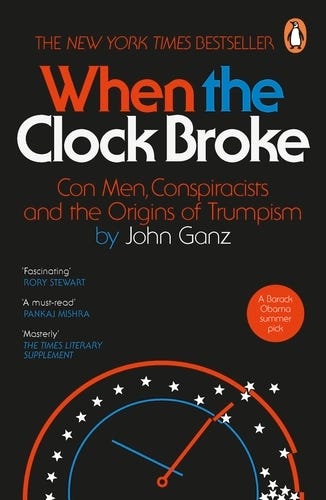Dear Unpopular Fronters,
More to come, hopefully soon, but for now, please check out my latest column in The Nation:
Trump’s fantasized American industrial rebirth also has this future-past character. Even the mechanism is a throwback: 19th-century protectionism to rebuild a 21st-century nation. The historian Jeffrey Herf has called this fetishization of technology and industry alongside an authoritarian government and the reimposition of a hierarchal social order “reactionary modernism”—a label that fits both Trump and his Silicon Valley supporters to a T. Lenin once said that “communism is Soviet power plus the electrification of the whole country.” Reactionary modernism, Herf [in effect says,] is “electrification minus the Enlightenment
Also, for U.K. readers, When the Clock Broke is out today in your country! To coincide with the British release, I have an essay in The Financial Times on Trump’s politics of national despair:
Donald Trump is one of the world’s most recognisable symbols of wealth. Making himself synonymous with prosperity has been one of the secrets to his success. To many Americans, Trump has come to represent something like money itself. But, as his critics often remind us, he also represents the other side of the balance sheet: rampant debt, financial trickery, insolvency and bankruptcy.
Trump represents capitalism not just in its growth phase, but also in chaos and crisis. And, on some level, he knows that. In 2016, he declared himself the “king of debt” and, in 1992, after his brush with ruin, he told New York magazine: “I was the cover boy, I was the leader of the depression,” making his own reversal of fortune emblematic of that era’s downturn. He was on to something. That mini “depression” of the early 1990s was one of the first signs of a wider crisis of liberal democracy and free-market capitalism that gave birth to what I’ve called a politics of national despair.
Understanding Trump’s political success and possible trajectory is the great preoccupation of our times. Endless hours of debate have been given over to parsing what Trump “really believes” or what “Trumpism” really consists of. But the best way to understand Trump is to look at his brush with failure during this earlier moment of American crisis — and the way in which he would later take up the politics of national despair for his own ends.
Trump’s life provides an uncanny microcosm of the trajectory of the country: first, in the 1980s, the rather tacky, fabulous success made possible by financial chicanery, and then the downfall, the ignominious bankruptcies and near liquidation of his assets. In the 1990s, Trump’s outlook on life became more angry, dour, paranoid. So did that of the United States.
Please find it at your local shop. And if you do buy it, why not post a photo on your social media to show what a clever chap or lass you are?

